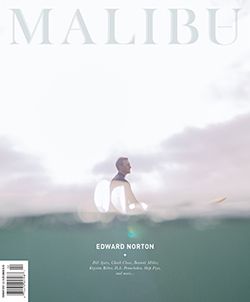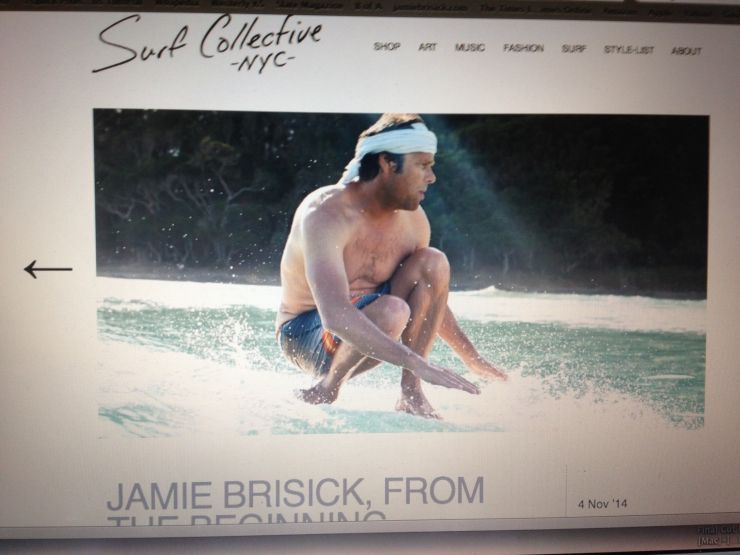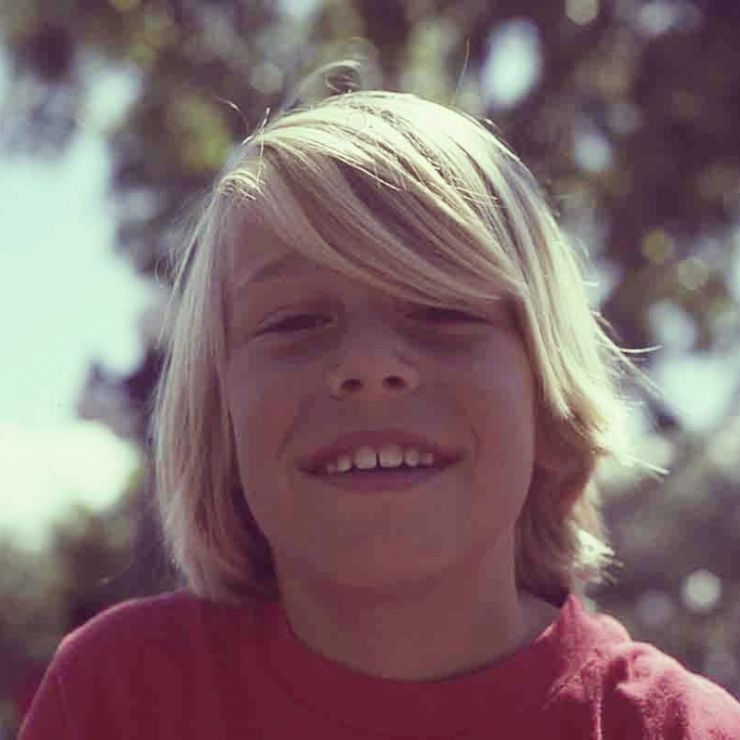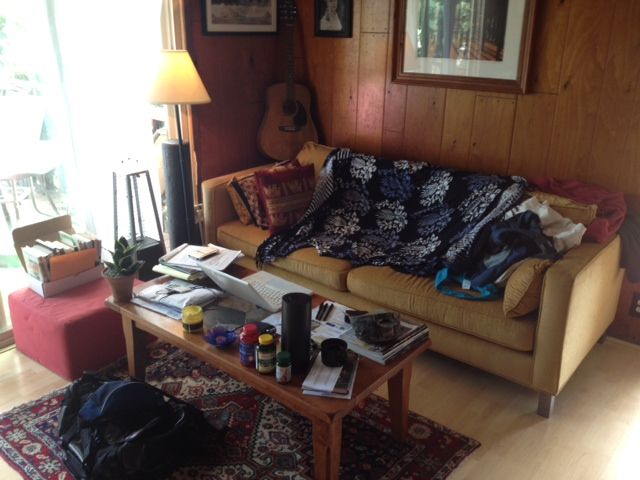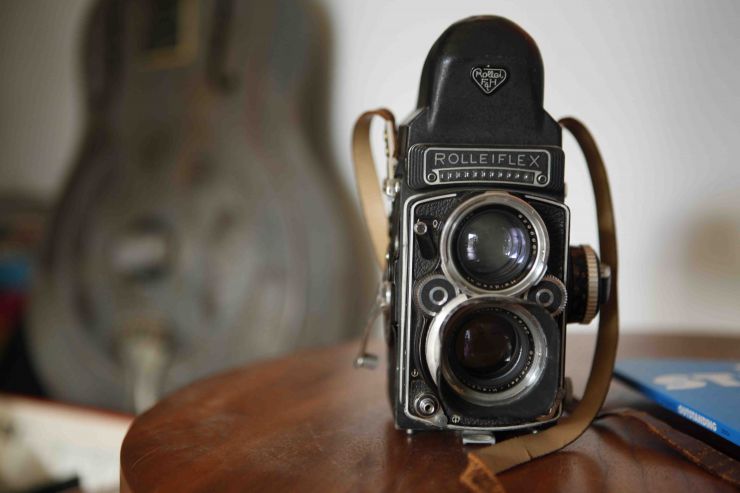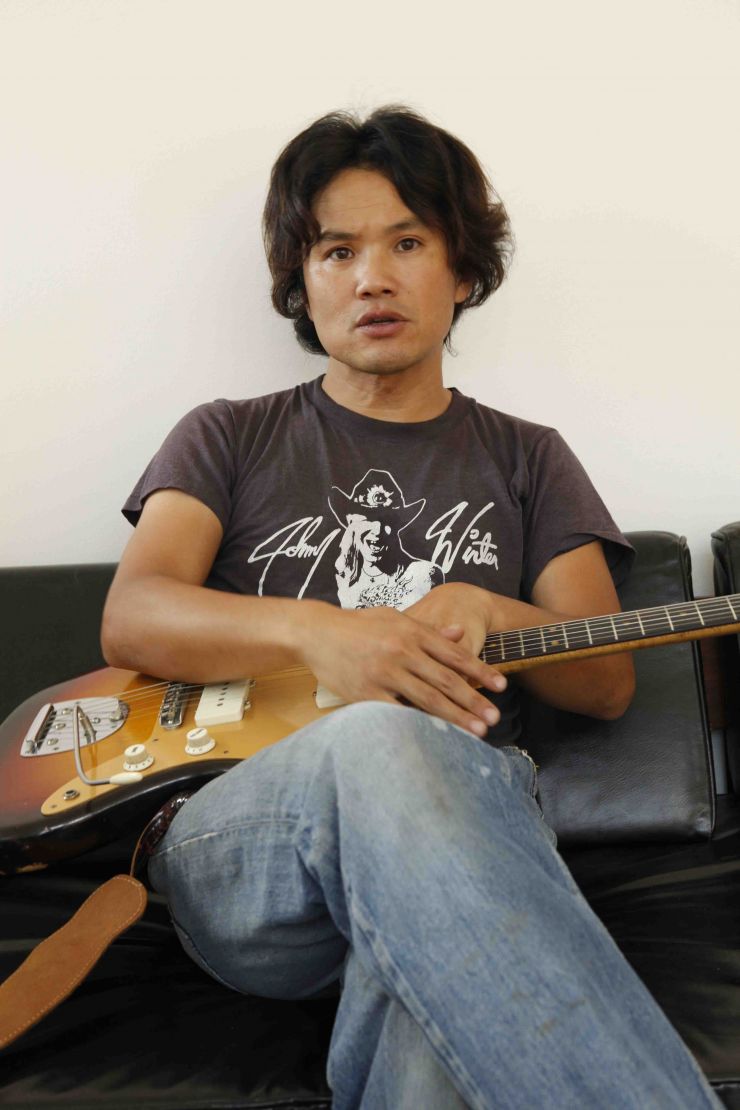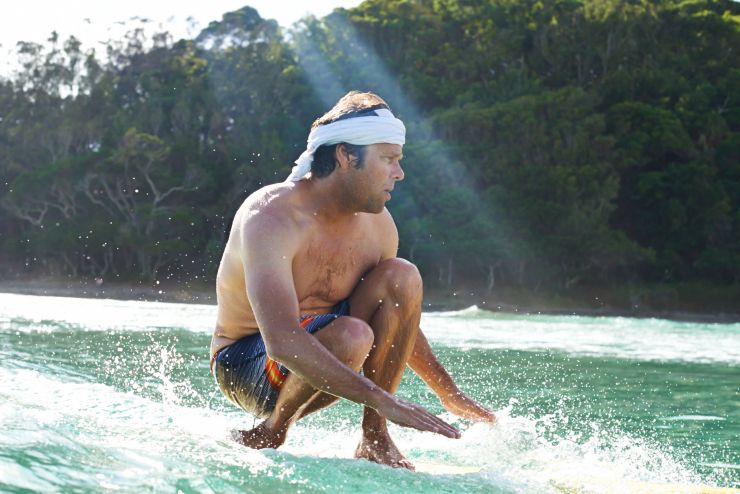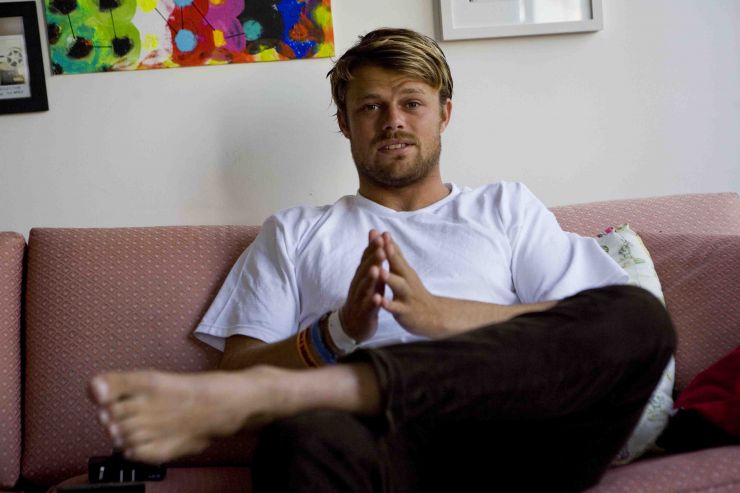On a bright Sunday morning at a little reef break in front of the Malibu Colony, Edward Norton straddled his yellow longboard and studied the ocean. A swell loomed. He paddled out to meet it, wheeled around, stroked, and hopped to his feet. He stood tall with slightly bent knees and winged arms. Across the water he glided, a contrail of foam spurting from his tail. I watched from behind. The tide was so high, the waves breaking so close to the beachfront homes that it looked as if he were about to crash through a plate glass window and land in someone’s living room.
Between waves we talked about travel. “If you travel, I mean if you really travel, you realize how none of this entertainment industry stuff means anything.” We joked about the people eating breakfast on their deck not 100 feet away. “You ride through on a wave, snatch up a pain au chocolat.” I asked him how he got into surfing. He told me that he’d gotten bucked off a horse and cracked three vertebras while filming The Painted Veil in China. He went to Bali to heal and took surfing lessons. “That was not quite 10 years ago, and it just took off from there. It’s actually one of the few addictions that’s healthy. I think it is an addiction, I literally think you get serotonin from it because it delivers contentment and well-being and a sense of health, and there is nothing about it that’s bad for you.”
Norton was ebullient. Water dripped from his dark brown hair and gesticulating hands. It was odd to see such a recognizable face clad in a wetsuit and surrounded by shimmering Pacific Ocean. Just outside of us, in the kelp beds, a diver scoured the reef with a spear gun. “I’ve been diving and sailing since I was a teenager,” Norton told me.
Just then, a swell popped up. He whipped around, stroked, and hopped to his feet. With his leading arm, fingers pointing the way, he angled left across the wave’s high line. As it steepened, he found a great flow. His style was graceful, he soared magnificently, the same kind of soaring he brings to his characters.
In Primal Fear, for which he was Oscar nominated for best supporting actor in 1996, he played Aaron Stampler, an altar boy charged with the murder of a Catholic archbishop. In American History X (for which he was nominated again two years later, this time for best actor), he played Derek Vinyard, a former neo-Nazi leader just released from prison after serving three years for voluntary manslaughter. In Fight Club he played an everyman who’s dissatisfied with his white-collar life. Most recently, in Birdman, he played Mike Shiner, a devout Broadway actor. Birdman is a black comedy about Riggan Thomson (played by Michael Keaton), a washed-up Hollywood actor trying to resuscitate his career by writing, directing, and starring in a stage adaptation of the Raymond Carver short story “What I Talk About When I Talk About Love.” Shiner riveted me. I walked into the movie theater in a depressed, ponderous mood. Shiner whirlwinded into the story with balls and fury. He was all about digging deep, pushing beyond. He was a reminder that if there’s nothing at stake, you’re not really living. I exited the theater galvanized and inspired.
“Edward is someone who comes with a huge amount of ideas,” Naomi Watts told me in a phone interview. Watts is excellent alongside Norton in Birdman. (They also did The Painted Veil together.) “Edward’s like a brother to me. He has this wonderful combination of being incredibly serious and approaching things from almost a scientific point of view, very cerebral, but yet he has this wonderfully raw instrument. His instincts are so pure and so true and so free as well. And as serious as he is, he’s also incredibly fun.”
After surfing, we drove north on PCH in Norton’s rented white Prius — him at the wheel, me shotgun. Norton wore a gray Triumph motorcycle T-shirt, faded jeans and black sneakers. His hazel eyes burst with a post-surfing glow. I told him my response to Shiner in Birdman. His right hand danced and twirled as he spoke.
“At face value, I was just completely thrilled by the script. I thought it was so rich on so many levels. It was funny. It was penetrating in terms of the way it rolled around in that fundamental struggle everybody has with the ego. It was inside a world I love: theater. And like you said, the character was such a dervish of contradictions. He seems to have this kind of preening self-regard and arrogance, but then he also turns out to be very philosophically rigorous and kind of has the artistic sophistication and maturity to back up some of his excesses. And then it turns out he’s also got actually a very deflated view of himself as a person, you know, as a person outside of his work. So he kept emerging, he kept deepening by layers as you read it.”
We passed Corral Beach. The Sunday crowd was filling in. Convertibles and SUVs reversed into parking spots. A trio of stand-up paddlers moseyed across the dazzling water. Norton described a three-phase lead-up to his role in Birdman. First, he was a huge fan of Iñárritu and his work, in particular the Mexican-Spanish film Biutiful, in which Javier Bardem plays Uxbal, a terminally ill single father of two young children. Second, he loved the lightheartedness of the script. “It seemed to be able to laugh a little more at the absurdity of it all, but it was still full of the same existential struggle that so many of his other films have.” The third thing was the filmmaking approach. They shot each scene of Birdman as a single, unbroken camera move. There were no edits. “It created this cohesion; it affected the nature of the collaboration,” said Norton. “Every single shot, all the crew and all the cast were involved every time and all reliant on each other — all in this dependent symbiosis, and there was no escaping. It was sort of a do-or-die each day.”
We turned left at Heathercliff, pulled into the Point Dume Plaza and parked. Entering a crowded SunLife Organics, I noticed the line of customers noticing Norton. We beelined for the phone-in register. The girl behind the counter turned from the customer she’d been helping and smiled warmly at the famous actor. “Did you place an order?” she asked. Norton asked the customer if she was finished. She nodded a starstruck yes. We got our smoothies, exited the back door and found a seat at a table away from everyone. I suddenly flashed on Monty Brogan, the character Norton played in Spike Lee’s 25th Hour, a drug dealer about to do seven years in prison. Like Shiner, he was on that edge of life in which divine truths reveal themselves. I asked Norton if he looks for these qualities in the characters he plays.
“No. I’m not looking for a consistency of philosophy. I’m more interested in things that are looking at the various forms of emotional turmoil that we are in as a people. And then the role you play within that is so secondary; it might be on the one side or the other. Fight Club is about a young man’s crisis to feel authentic and masculine within the context of all kinds of things that make life feel kind of like Novocain. But in that case I’m not playing the vital one, I’m playing the one suffering, I’m playing the one whose life has fallen far away from anything he admires. And he goes a little crazy to try to get back toward something that feels like a life that he can feel happy about. And Tyler [played by Brad Pitt] is obviously the more liberated, philosophically grounded force.
“In Birdman, I think Shiner is more that. Shiner is more in the role of the disrupter, in the role of the guy challenging the baseline. But I think American History X is so much more different, but absolutely the draw in that was the notion of the way that rage is a distortion. Rage creates this huge distortion of the way you see the world around you, and it ultimately becomes a self-defeating thing. The idea of working through rage was what that movie was all about. With The Painted Veil, I think I was drawn to that because it’s really about the hugely transformative power of forgiveness. It’s about two people who essentially loathe each other, who actually find their way around to an authentic understanding and appreciation and love for each other by forgiving each other.”
A woman approached our table, the customer from inside SunLife. She apologized for interrupting us, thanked Norton for being so considerate. “It was the cashier’s fault, not yours,” she said, referring to our unintentional line cutting. Norton was cordial. What she really wanted was to get closer to him, but she saw the little digital recorder between us, apologized again, and moved on.
On his Wikipedia page, it says that Norton eschews celebrity culture: “If I ever have to stop taking the subway, I’m going to have a heart attack.” I asked him about this.
“L.A. is an industry town, and industries intrinsically create what I would call false hierarchies. It’s everything Birdman is about, like it ignites voices in the head. And keeping those voices at a remove, I find, is healthier,” he said. “I find New York to be a more naturally egalitarian city. There’s so many people doing so many things there that the relative value, no matter what you do and no matter what level you do it, there’s just kind of this equalizing effect to the density and the breadth of New York, and I love that. I’ve lived there since I was 21 years old, and New York’s this unparalleled density. The diversity of encounters you have, the collisions you have with people who do things so wildly different from you, whose backgrounds are so different from you — it’s rich. I just get off on it, and I think, as a town, it’s overall less concerned with you.”
Norton took a long sip of his smoothie. He tapped something into his phone then put it back in his pocket. I asked if the characters he plunges into take a giant chunk out of him. He responded with an emphatic no.
“Actually, I find it to be a very enriching and expansive thing. It’s like a skeleton key into every door. Each and every one is this investigatory process that’s essentially like someone saying, ‘Your job, done well, is to go educate yourself about a new world of experience and a type of experience and a type of person and a skill set or whatever, and absorb it, and go meet people or read up.’ It’s like this license to learn, really. And it’s always positive; I always find that I carry away, literally, skills I never had. Like living in China for five months and going to these places and making these friends and having these experiences that’ll stay with you for the rest of your life. I’ve had experiences where, dead in the middle of them, I was looking around and looking at the people and just going: Can you believe we get to do this? Like this is just ridiculous!”
He did not always get to do this. Born August 18, 1969, Edward Harrison Norton grew up in Columbia, Md. He had a blessed upbringing; his father is a celebrated attorney and campaigning environmentalist; his mother, who died in 1997, was an educator. “My parents had a really well-developed appreciation for theater and film and music and art,” he told me. “I literally saw Annie Hall with my mom when I was like 11 or 12.” In high school, he acted in plays and made home movies. At Yale, where he graduated in 1991 with a bachelor’s in history, he acted in university productions alongside Ron Livingston and Paul Giamatti. After graduating, he worked in Japan, consulting for his grandfather’s nonprofit organization, Enterprise Community Partners. It wasn’t until he was in his early 20s, living in New York City, that he realized he wanted to pursue acting full time. His breakthrough role was in the Edward Albee play Fragments at the Signature Theatre Company in 1993. That led him to the film Primal Fear, and off he went. In between his better-known films he’s played saintly comic figures in Woody Allen’s Everybody Says I Love You, Danny De Vito’s Death to Smoochy and Keeping the Faith (which he also directed), and the Hustler publisher’s long-suffering lawyer in The People vs. Larry Flynt.
I asked Norton how he goes about choosing the roles he plays.
“I think actors themselves have varying degrees of plasticity. I think there are really good actors who are also very iconic, like Harrison Ford is a very iconic actor, a very excellent actor and a very iconic actor because he comes to stand for certain qualities that we like to see in ourselves and things. And then there are actors at the other end of the spectrum that I think are more chameleonic — Daniel Day Lewis or Dustin Hoffman, for example. And I think their talent is the antithesis of being iconic. They disappear, absorb, and then create a construct, use themselves as an instrument for creating something. And those people, I think you would say have great plasticity, and other people have less plasticity.
“And likewise, roles, characters, can have more or less plasticity. [CN1] So you take a movie like Gladiator: Maximus, that’s not a very plastic role. You need someone like Russell Crowe, who just is right there. There are not a lot of people who could play that role, and that means the role itself, there’s not that many ways to interpret it. Whereas, the narrator in Fight Club, he’s an everyman, there’s a version of that done by me, there’s a version of that that could be done by someone else, so that role’s more plastic. And the two have to overlap. A lot of times I’ve looked at things and questioned whether my plasticity overlaps with the role’s plasticity, and sometimes I’ve had doubts. I will say some of my most interesting experiences have been the ones that I was unsure of whether I could be the person. Like American X, I didn’t think the role was very plastic; that was a very, very specifically drawn character. And it was just like, ‘I’m me, I weigh 155, and is my plasticity capable of pulling me across to what it needs?’ And I had my doubts, but I was really interested in it, so I worked to think about what would I have to do, and could I get myself there? You know what I mean? And then you realize the role can be more inventive because the role has wider boundaries on it in a way, and once you figure out that it’s of interest, then you hunt for access points, like: Is the physicality the access point? Is the emotional state the person’s in the access point? Is it the clothes they wear, the expression?”
Norton is married to Canadian film producer Shauna Robertson. They have a 1-year-old son. Following in his father’s lead, he is an environmental and social activist. In 2009, he ran in the New York City Marathon to raise money for the Maasai Wilderness Trust, of which he is the American branch president. In 2010, he was designated as the U.N. Goodwill Ambassador for Biodiversity. That same year he launched a website called Crowdrise, which uses a social networking platform to help raise funds for charity. “When you’re getting paid too much money and you have people paying attention, you have to be a little bit heedless not to use that to try and engage in meaningful ways with people,” he said. “I don’t have a lot of material needs in my life, so I try and support the things that I’m interested in.”
I asked him what he’d like to accomplish over the next five or 10 years.
“Within the context of films there’s a ton of stuff I am really interested in exploring. I’ve been writing a lot more. I’ve always written films, I’ve taken studio-writing gigs for money — literally just worked as a journeyman writer, not put my name on things, just been part of my working career. And I’ve written films, other films, and produced a lot of films and directed one, and I’m more interested in doing more of that. I wrote a film that I’m going to direct that I am trying to put together right now, and that holds a lot of interest for me. I’ve always been very inspired by people like Alejandro [Iñárritu], people like Wes Anderson, people like Spike Lee — these people I’ve been lucky enough to work with, who kind of conceive and write and really build these worlds and these visions.” He took the last sip of his smoothie. “I’m not bored with acting at all, but the hunger to sort of exercise those compulsions is less sharp than it used to be. I’ve gotten to work on a lot of really wonderful stuff with wonderful people, but I think it’s elevated my interest in just building things from scratch out of my own imagination, and seeing them all the way through, because it’s hard work. Those things are really hard work, and they’re a bigger investment, and I think I feel more ready than ever to kind of lean into that a little bit more.”
We tossed our cups in the trash and headed back to the parking lot. Along the way, a few tables’ worth of diners saw Norton and did double takes. We got back in his car and headed south down PCH.
“Did you see Scorcese’s doc on Bob Dylan, No Direction Home?” he asked me.
“I did.”
“You talk about the managing of the strange phenomenon of getting to be well known. There’s no playbook for those kinds of things, but in a weird way, I find things like watching Dylan fielding this thing coming at him so inspiring. People were throwing the expectations and needs of an entire generation on Dylan. He’s like 20 or 21 years old, and people are saying, ‘Everybody says you’re the voice of your generation,’ and he just says, ‘That’s nothing I can relate to.’ And they say, ‘Tell us about the work; what are you trying to say in it? And he says, ‘I’m not going to talk about what it means. What do you think it means?’ And he doesn’t just obfuscate, he just deflects. He’s in that film going, ‘There’s nothing you can say to me that’s going to make me stand here and open up the Cliff Notes on what I’ve just done. There’s nothing about that that could serve what I’ve done better than the thing itself.’ And it’s so incredible to me that someone so young had the presence of mind to say, ‘This needs to be resisted with everything I’ve got. Like nothing about the ego stroke of this, the compliment that people think is in it; I have to defend the rigor of what I’ve done against people wanting me to now sit here and dissect it for them.’ There are so few people who grasp that, at that age especially.”
Norton rolled down his window. We were headed down the hill at Latigo Canyon. The sky was cloudless, the ocean a mesmerizing sapphire blue. A set of waves made their way to shore. A small peak crashed on the sandbar and peeled down the beach.
“Look at that,” he said excitedly, the glint of a true surf addict in his eyes. “We’re supposed to get a few waves tomorrow morning.”
*Special thanks to Takuji Masuda
